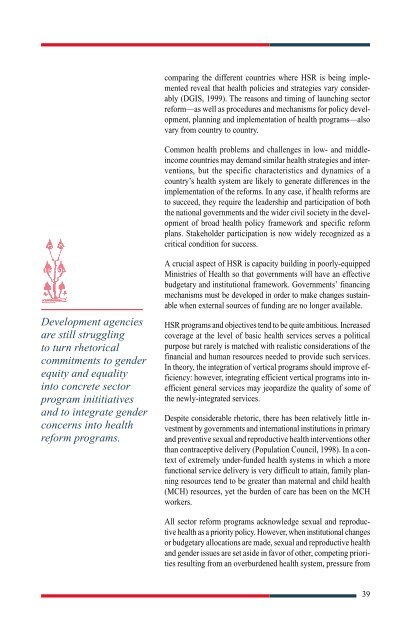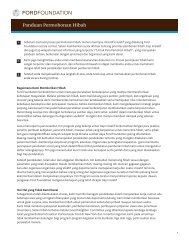Globalization, Health Sector Reform, Gender and ... - Ford Foundation
Globalization, Health Sector Reform, Gender and ... - Ford Foundation
Globalization, Health Sector Reform, Gender and ... - Ford Foundation
- No tags were found...
You also want an ePaper? Increase the reach of your titles
YUMPU automatically turns print PDFs into web optimized ePapers that Google loves.
comparing the different countries where HSR is being implementedreveal that health policies <strong>and</strong> strategies vary considerably(DGIS, 1999). The reasons <strong>and</strong> timing of launching sectorreform—as well as procedures <strong>and</strong> mechanisms for policy development,planning <strong>and</strong> implementation of health programs—alsovary from country to country.Common health problems <strong>and</strong> challenges in low- <strong>and</strong> middleincomecountries may dem<strong>and</strong> similar health strategies <strong>and</strong> interventions,but the specific characteristics <strong>and</strong> dynamics of acountry’s health system are likely to generate differences in theimplementation of the reforms. In any case, if health reforms areto succeed, they require the leadership <strong>and</strong> participation of boththe national governments <strong>and</strong> the wider civil society in the developmentof broad health policy framework <strong>and</strong> specific reformplans. Stakeholder participation is now widely recognized as acritical condition for success.Development agenciesare still strugglingto turn rhetoricalcommitments to genderequity <strong>and</strong> equalityinto concrete sectorprogram inititiatives<strong>and</strong> to integrate genderconcerns into healthreform programs.A crucial aspect of HSR is capacity building in poorly-equippedMinistries of <strong>Health</strong> so that governments will have an effectivebudgetary <strong>and</strong> institutional framework. Governments’ financingmechanisms must be developed in order to make changes sustainablewhen external sources of funding are no longer available.HSR programs <strong>and</strong> objectives tend to be quite ambitious. Increasedcoverage at the level of basic health services serves a politicalpurpose but rarely is matched with realistic considerations of thefinancial <strong>and</strong> human resources needed to provide such services.In theory, the integration of vertical programs should improve efficiency:however, integrating efficient vertical programs into inefficientgeneral services may jeopardize the quality of some ofthe newly-integrated services.Despite considerable rhetoric, there has been relatively little investmentby governments <strong>and</strong> international institutions in primary<strong>and</strong> preventive sexual <strong>and</strong> reproductive health interventions otherthan contraceptive delivery (Population Council, 1998). In a contextof extremely under-funded health systems in which a morefunctional service delivery is very difficult to attain, family planningresources tend to be greater than maternal <strong>and</strong> child health(MCH) resources, yet the burden of care has been on the MCHworkers.All sector reform programs acknowledge sexual <strong>and</strong> reproductivehealth as a priority policy. However, when institutional changesor budgetary allocations are made, sexual <strong>and</strong> reproductive health<strong>and</strong> gender issues are set aside in favor of other, competing prioritiesresulting from an overburdened health system, pressure from39
















